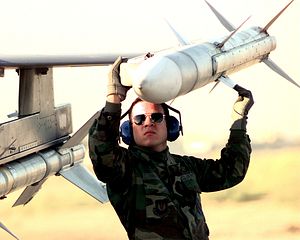In his recent tour of East Asia, Donald Trump made a point of touting U.S. arms sales, which bring cash to the United States and jobs to American workers. Trump’s point is straightforward, if not often acknowledged in U.S. policy circles: arms sales not only extend U.S. influence, but also benefit the United States economically. The United States has enjoyed a dominant global position in arms transfers since at least the early 1990s, despite export restrictions that occasionally restrict transfers for political and technological reasons.
U.S. market position depends on two factors; the technological superiority of U.S. equipment, and the political value in establishing a defense relationship with the United States. Historically, China arms export strategy has been built around exploiting the edges of these U.S. advantages. First, China sells military equipment at much lower prices that the United States, which for some types of equipment (and some sellers) is ideal. Second, China will sell to just about any customer.
But it may not be too long before the United States needs to worry about competition directly in its niche. China is taking steps to modernize the relationship between its defense industrial base and its technology sector, with the hope of generating investment in firms that work at the juncture between the latter and the former.
Leveraging the relationship between civilian and military technology is how the United State achieved military superiority over the Soviet Union during the Cold War. It’s also been a preoccupation of advocates of the “Third Offset,” which hopes to further harness the U.S. tech sector in the service of maintaining American superiority in military technology. And there are indications that the Chinese are ever-more-ready to challenge the United States in this arena.
The Chinese defense industry remains far more autarkic than the United States’, and is still largely state controlled. But allowing heavy civilian investment into military-related civilian industries, as well as focusing on building linkages between civilian industries and the military, could accelerate Chinese innovation. If China can successfully connect its burgeoning tech industry with its defense industrial base (a project that even the United States has struggled with), then it can accomplish something that the Soviet Union utterly failed at.
Obviously, many obstacles remain, some of which the United States also faces. The task of integrating China’s state-owned defense giants with its private sector tech companies will be enormously complicated, with many potential pitfalls. Not the least of these is convincing Chinese tech firms that their technologies are safe in the hands of state-owned defense giants, a task that is probably even more difficult than getting U.S. tech firms to work with Lockheed Martin and Raytheon. The eventual outcome might look something like the European model, where large, state-controlled defense firms have a tolerably good relationship with the civilian sector. The difference would be that, as in the United States, the defense industrial base can count on huge, consistent government outlays.
If China can square the circle, it can compete with the United States not only on the air and at sea, but also in the international arms market. Chinese arms in the hands of traditional U.S. export partners may not be quite as dangerous as those in Chinese hands, but they have the potential to undercut a dominant U.S. market position.

































